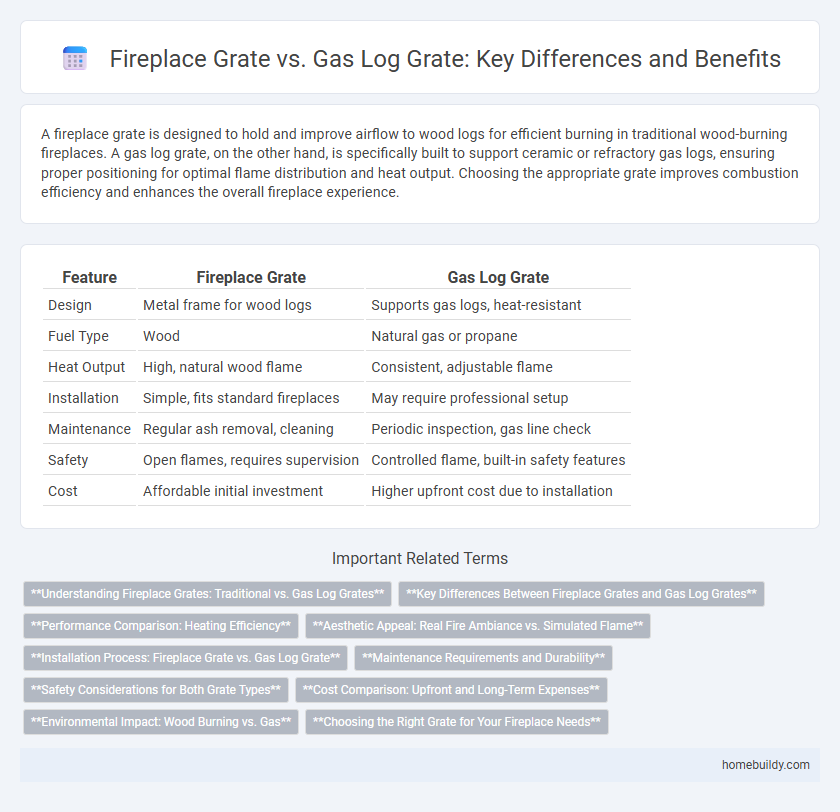A fireplace grate is designed to hold and improve airflow to wood logs for efficient burning in traditional wood-burning fireplaces. A gas log grate, on the other hand, is specifically built to support ceramic or refractory gas logs, ensuring proper positioning for optimal flame distribution and heat output. Choosing the appropriate grate improves combustion efficiency and enhances the overall fireplace experience.
Table of Comparison
| Feature | Fireplace Grate | Gas Log Grate |
|---|---|---|
| Design | Metal frame for wood logs | Supports gas logs, heat-resistant |
| Fuel Type | Wood | Natural gas or propane |
| Heat Output | High, natural wood flame | Consistent, adjustable flame |
| Installation | Simple, fits standard fireplaces | May require professional setup |
| Maintenance | Regular ash removal, cleaning | Periodic inspection, gas line check |
| Safety | Open flames, requires supervision | Controlled flame, built-in safety features |
| Cost | Affordable initial investment | Higher upfront cost due to installation |
Understanding Fireplace Grates: Traditional vs. Gas Log Grates
Fireplace grates support burning wood by improving airflow and enhancing heat distribution, while gas log grates are designed specifically to hold gas logs safely and ensure proper flame exposure. Traditional fireplace grates are typically made of heavy-duty cast iron or steel to withstand high temperatures and hold solid fuel securely. Gas log grates, often made of heat-resistant materials, prioritize efficient gas combustion and aesthetic flame presentation without the need for ash management.
Key Differences Between Fireplace Grates and Gas Log Grates
Fireplace grates are designed to hold solid wood logs securely above the fireplace floor, allowing better airflow for efficient burning and ash collection. Gas log grates, specifically made for gas fireplaces, support artificial ceramic logs and are engineered to withstand intense, consistent heat without warping or rusting. Unlike fireplace grates, gas log grates do not facilitate wood combustion but optimize gas flame distribution for realistic log appearance and efficient heat output.
Performance Comparison: Heating Efficiency
Fireplace grates designed for wood burning typically offer superior heating efficiency by allowing better air circulation and sustained combustion, resulting in higher heat output. Gas log grates, while more convenient and easier to control, generally produce less radiant heat due to the combustion characteristics and lower flame temperatures. Measuring heat output in British Thermal Units (BTUs), wood grates often exceed gas log grates, providing more effective warmth in traditional fireplace settings.
Aesthetic Appeal: Real Fire Ambiance vs. Simulated Flame
A fireplace grate designed for real wood enhances a room's aesthetic appeal by offering the authentic crackling sound, flickering shadows, and dynamic flame patterns that a gas log grate cannot replicate. Gas log grates create a consistent, controlled flame with cleaner lines, providing a polished, low-maintenance visual but lack the organic variability and warmth of real fire ambiance. Choosing between a traditional wood grate and a gas log grate hinges on prioritizing the natural, immersive atmosphere of real fire over the convenience and sleek appearance of simulated flames.
Installation Process: Fireplace Grate vs. Gas Log Grate
Fireplace grates are typically simple to install, requiring no modifications to the fireplace structure and simply placed inside the firebox to support wood logs. Gas log grates often involve a more complex installation process, including connection to a gas line, securing burners, and ensuring proper ventilation and safety measures. Professional installation is recommended for gas log grates to comply with local codes and ensure efficient gas flow and operation.
Maintenance Requirements and Durability
Fireplace grates made of heavy-duty steel or cast iron offer high durability and require regular cleaning to remove ash and soot buildup to maintain optimal function. Gas log grates, constructed from heat-resistant materials like steel with ceramic coatings, demand less maintenance due to reduced ash production and simpler cleaning procedures. The durability of gas log grates varies based on fuel type and exposure, whereas traditional fireplace grates withstand prolonged high heat and physical wear with proper upkeep.
Safety Considerations for Both Grate Types
Fireplace grates constructed from heavy-duty steel provide durable support for wood logs while maintaining ventilation to reduce smoke hazards. Gas log grates, designed to accommodate artificial logs and regulate flame dispersion, must adhere to strict manufacturer safety guidelines to prevent gas leaks or carbon monoxide buildup. Proper installation, regular inspection, and ensuring adequate airflow are critical safety measures for both wood and gas log grates to protect against fire risks and indoor air pollution.
Cost Comparison: Upfront and Long-Term Expenses
Fireplace grates typically have a lower upfront cost, ranging from $50 to $150, while gas log grates often cost between $200 and $500 due to their integrated gas components. Long-term expenses for traditional fireplace grates include wood fuel and regular chimney maintenance, averaging around $300 annually. Gas log grates incur higher initial installation costs and ongoing natural gas bills but reduce maintenance needs, potentially lowering overall expenses over time depending on usage.
Environmental Impact: Wood Burning vs. Gas
Wood-burning fireplace grates release carbon dioxide, particulate matter, and volatile organic compounds contributing to air pollution and deforestation. Gas log grates burn cleaner, producing fewer pollutants and less carbon emissions, making them a more environmentally friendly option. Choosing gas logs reduces the overall carbon footprint and improves indoor air quality compared to traditional wood burning.
Choosing the Right Grate for Your Fireplace Needs
Choosing the right grate for your fireplace depends on the type of fuel and heating preferences. A traditional fireplace grate is designed to hold wood logs securely, promoting optimal airflow for efficient burning and heat output. In contrast, a gas log grate is specifically engineered to support ceramic or real gas logs, ensuring safe gas flow and consistent flame appearance without the mess of wood ash.
Fireplace grate vs Gas log grate Infographic

 homebuildy.com
homebuildy.com